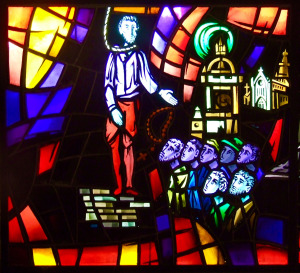How did a simple Galilean fisherman come to be the patron saint of Scotland?
The Gospel of John tells us that Andrew heard John the Baptist refer to Jesus as the Lamb of God. “The first thing Andrew did was to find his brother Simon and tell him “We have found the Messiah” (that is the Christ). And he brought him to Jesus.” (John, 1:41-42). Thus, Andrew was one of the first apostles.
Legend has it that Andrew spent his later life preaching around Greece and Asia Minor, and he was crucified on an X-shaped cross by the Romans in Patras, Greece. His remains were later moved to Constantinople, and, it is said, to Amalfi in the 13th century, where they rest in the Cathedral to this day. However, legend also says that a Greek monk, St Regulus, had a vision in which he was told to take some of the relics “to the ends of the earth”. St Rule, as he is also known, eventually came to Fife, where the present town of St Andrews is situated.
In 832 AD, St Andrew is said to have appeared to a Pictish king, Angus, the night before the battle of Athelstaneford in modern-day Lothian. On the day of the battle, a Saltire – an X-shaped cross – appeared in the sky over the battlefield, and the Picts triumphed over the Northumbrians.
In the 17th century, the interior of the Cathedral of St Andrews, along with the relics and the shrine in which they were held, was destroyed during the Reformation.
In 1879, following the Restoration of the Catholic Hierarchy a year earlier, the then Archbishop of Amalfi gave St Andrew’s shoulder blade to St Mary’s Cathedral in Edinburgh; and some ninety years later, Pope Paul VI gave further relics to the newly created Scottish Cardinal Gordon Joseph Gray, in St Peter’s Rome, with the words ‘Peter greets his brother Andrew’. Cardinal Gray was the first Scottish Cardinal in four hundred years. These relics now form part of the National Shrine to St Andrew in the cathedral.
30 November is reputedly the day on which St Andrew was crucified, and is now Scotland’s national day. And so Scots and the peoples of Romania, Greece, Russia and Barbados remember and celebrate their patron. They are joined by the people of Amalfi, Bulgaria, Germany, Ukraine and Poland who also have their St Andrew’s Day traditions. And it all started with the simple man who left his nets by the Sea of Galilee to live an extraordinary life of courage and faith.

